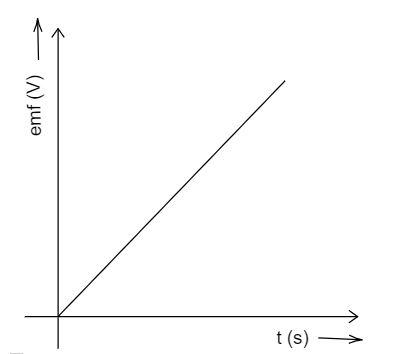
There is an inductor of $5\,mH$. Current flowing through the inductor at any instant of time is given by the relation.
$I = {t^2} + 4$
If, is in ampere and $'t'$ in sec, find out
(i) Emf induced in the inductor at $t = 1$ and $t = 3\,s$ .
(ii) Plot $ E \,v/s\,t$ graph.
Answer
220.2k+ views
Hint: Use the formula of the emf given below and substitute the value of the induction and the equation of the current. Differentiate the current equation, and substitute the value of the time taken in it to find the emf at that corresponding time. The emf is directly proportional to time taken.
Useful formula:
The formula of the emf is given by
$ E = L\dfrac{{di}}{{dt}}$
Where $ E $ is the emf of the inductor, $L$ is the induction and $i$ is the current flowing through the inductor circuit.
Complete step by step solution:
It is given that the
The inductance of the inductor, \[L = 5\,mH = 5 \times {10^{ - 3}}\,H\]
The current through the inductor at time, $i = {t^2} + 4$
(i) Let us calculate the value of the emf through the inductor at $t = 1$ . First, write the formula of the emf,
$ E = L\dfrac{{di}}{{dt}}$
Substitute the known values in the above step,
$ E = 5 \times {10^{ - 3}} \times \dfrac{{d\left( {{t^2} + 4} \right)}}{{dt}}$
By performing differentiation in the above step,
$ E = 5 \times {10^{ - 3}} \times 2t$ -----(1)
Substituting the value of $t$ as $1\,{\text{second}}$ ,
$ E = 0.01\,V$
Let us calculate the emf for $t = 3\,s$ ,by substituting the value of $t$ as $3\,{\text{second}}$ ,
$ E = 5 \times {10^{ - 3}} \times 2 \times 3$
$ E = 30 \times {10^{ - 3}}$
$ E = 0.3\,V$
Hence the emf of the inductor is obtained as $0.01\,V$ for $1\,\operatorname{s} $ time and $0.3\,V$ for the time period of $3\,s$ .
(ii) The below graph shows the relation between the emf and the time taken for the current to flow. The emf is directly proportional to the current and thus the graph is straight line.

Note: The inductors can be functioned in two ways, first is to control signals and in the other is to store electrical energy. In the factor that helps to produce the emf, also generate the reactive fluxes that act against the produced emf.
Useful formula:
The formula of the emf is given by
$ E = L\dfrac{{di}}{{dt}}$
Where $ E $ is the emf of the inductor, $L$ is the induction and $i$ is the current flowing through the inductor circuit.
Complete step by step solution:
It is given that the
The inductance of the inductor, \[L = 5\,mH = 5 \times {10^{ - 3}}\,H\]
The current through the inductor at time, $i = {t^2} + 4$
(i) Let us calculate the value of the emf through the inductor at $t = 1$ . First, write the formula of the emf,
$ E = L\dfrac{{di}}{{dt}}$
Substitute the known values in the above step,
$ E = 5 \times {10^{ - 3}} \times \dfrac{{d\left( {{t^2} + 4} \right)}}{{dt}}$
By performing differentiation in the above step,
$ E = 5 \times {10^{ - 3}} \times 2t$ -----(1)
Substituting the value of $t$ as $1\,{\text{second}}$ ,
$ E = 0.01\,V$
Let us calculate the emf for $t = 3\,s$ ,by substituting the value of $t$ as $3\,{\text{second}}$ ,
$ E = 5 \times {10^{ - 3}} \times 2 \times 3$
$ E = 30 \times {10^{ - 3}}$
$ E = 0.3\,V$
Hence the emf of the inductor is obtained as $0.01\,V$ for $1\,\operatorname{s} $ time and $0.3\,V$ for the time period of $3\,s$ .
(ii) The below graph shows the relation between the emf and the time taken for the current to flow. The emf is directly proportional to the current and thus the graph is straight line.

Note: The inductors can be functioned in two ways, first is to control signals and in the other is to store electrical energy. In the factor that helps to produce the emf, also generate the reactive fluxes that act against the produced emf.
Recently Updated Pages
Mass vs Weight: Key Differences Explained for Students

Young’s Double Slit Experiment Derivation Explained

Electricity and Magnetism Explained: Key Concepts & Applications

JEE Energetics Important Concepts and Tips for Exam Preparation

JEE Isolation, Preparation and Properties of Non-metals Important Concepts and Tips for Exam Preparation

JEE Main 2021 July 25 Shift 1 Question Paper with Answer Key

Trending doubts
JEE Main 2026: Application Form Open, Exam Dates, Syllabus, Eligibility & Question Papers

Understanding Uniform Acceleration in Physics

Derivation of Equation of Trajectory Explained for Students

Hybridisation in Chemistry – Concept, Types & Applications

Understanding the Angle of Deviation in a Prism

How to Convert a Galvanometer into an Ammeter or Voltmeter

Other Pages
JEE Advanced Marks vs Ranks 2025: Understanding Category-wise Qualifying Marks and Previous Year Cut-offs

Dual Nature of Radiation and Matter Class 12 Physics Chapter 11 CBSE Notes - 2025-26

JEE Main Marking Scheme 2026- Paper-Wise Marks Distribution and Negative Marking Details

Degree of Dissociation: Meaning, Formula, Calculation & Uses

Ideal and Non-Ideal Solutions Explained for Class 12 Chemistry

Understanding the Electric Field of a Uniformly Charged Ring




